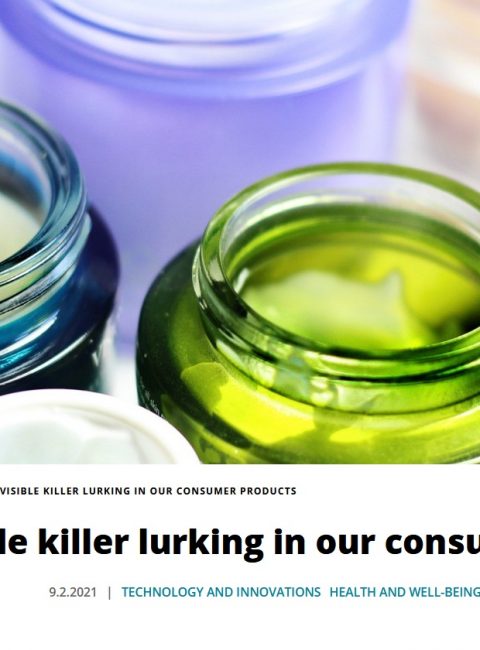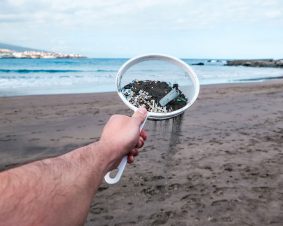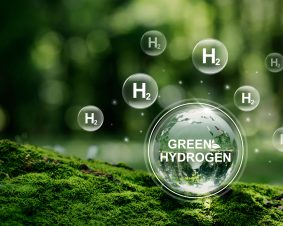 >
Spotlight April 2021: Nanomaterials and Fake News – a commentary based on an example
>
Spotlight April 2021: Nanomaterials and Fake News – a commentary based on an example
In February 2021, the article “The invisible killer lurking in our consumer products” appeared, describing nanoparticles as a greater danger than Corona [1]. “The use of nanomaterials” would be “unregulated” and “nanomaterials are so small that they cannot be determined once they are part of a product”. So what is the truth of these statements?
The article refers to a publication by Monikh et al. in which the transport of gold particles within the aquatic food chain from algae to daphnia to fish was studied [2]. To understand the uptake, accumulation and distribution of nanogold particles, both the number of particles and the mass were determined. The authors were able to show that only a small proportion of the gold particles ingested by algae were detectable in the fish (0.03%- 0.48%) and that a large proportion of the gold was excreted (49-58%).
The scientific achievement of this study lies in the development of a reliable method to determine the transfer of nanomaterials in a food chain. The transformation of the particles during their transfer through different organisms is taken into account (size, solubility). It is also possible to determine exactly in which parts of an organism particles are found and whether there is an accumulation via the food chain (which is not the case). The gold nanoparticles which were used should be considered as model particles, which were selected because of their good detectability. A general statement regarding the transfer of other nanomaterials through food chains cannot be derived from this.
In the publication by Monikh et al. no comparison was made with Corona and the allegedly non-existent regulation of nanomaterials is also not mentioned. Why then is it mentioned in the article on chemeurope.com?
One possible explanation could be that lurid and emotionally written texts reach a larger number of readers and are shared more often. Texts that play with human fear and generate the signal “danger” in the readers mind, spread faster. In the case of the example text, it is already clear from the headline that the word “killer” creates fear and that “our consumer products” are intended to address a broad target audience. Fake news is characterised by making claims that are not proven (no source is cited) or that statements are greatly reduced and thus a false picture is reproduced. Therefore, it is worthwhile to look at the original sources (if available).
In the case of the article, parts have been corrected (namely the sentences mentioned above), but the original article as well as the German translation is still available on chemeurope.com and the reference to the cited scientific study remains unclear [3,4].
Original publications:
[2] Abdolahpur Monikh, F., Chupani, L., Arenas-Lago, D. et al. Particle number-based trophic transfer of gold nanomaterials in an aquatic food chain. Nat Commun 12, 899 (2021).
[3] https://www.uef.fi/en/article/the-invisible-killer-lurking-in-our-consumer-products

Weitere Spotlights
Spotlight August 2022: Three-stage model for the formation of micro- and nanoplastic particles.
Plastic pollution is a global problem that will continue to affect humanity for more than 100 years. There is the visible pollution, e.g. plastic debris in the environment, which leads to death for many animals (because they mistakenly think the plastic is food and eat it or because they get caught in the plastic waste). […]
Read moreSpotlight April 2022: A new risk assessment of nanomaterials in 3D printing is needed
The use of nanomaterials in 3D printing has great potential. Due to the properties of nanoscale materials, many requirements can be implemented in 3D printing. However, these unique properties based on the size of the particles also lead to the need for new risk assessments. This is because if the nanoparticles are released in the […]
Read moreSpotlight July 2021: The Path to Digital Material Research – It is never too late to start
Machine Learning, Artificial Intelligence, Big Data…. Have you read these words lately? No, these are not just buzzwords. The digitalisation of science is an evolving topic that is gaining importance with each passing day. That is why this month we would like to introduce you to the article “Digital Transformation in Materials Science: A Paradigm […]
Read moreSpotlight October 2023: Improved hydrogen production through novel catalyst made of three metals
Hydrogen is one of the important energy carriers of the future when it comes to climate-relevant energy supply. For example, surplus electricity from wind turbines or solar plants can be converted into hydrogen, allowing the otherwise unused energy to be stored for longer periods. This hydrogen can be used to power trucks and buses for […]
Read more


